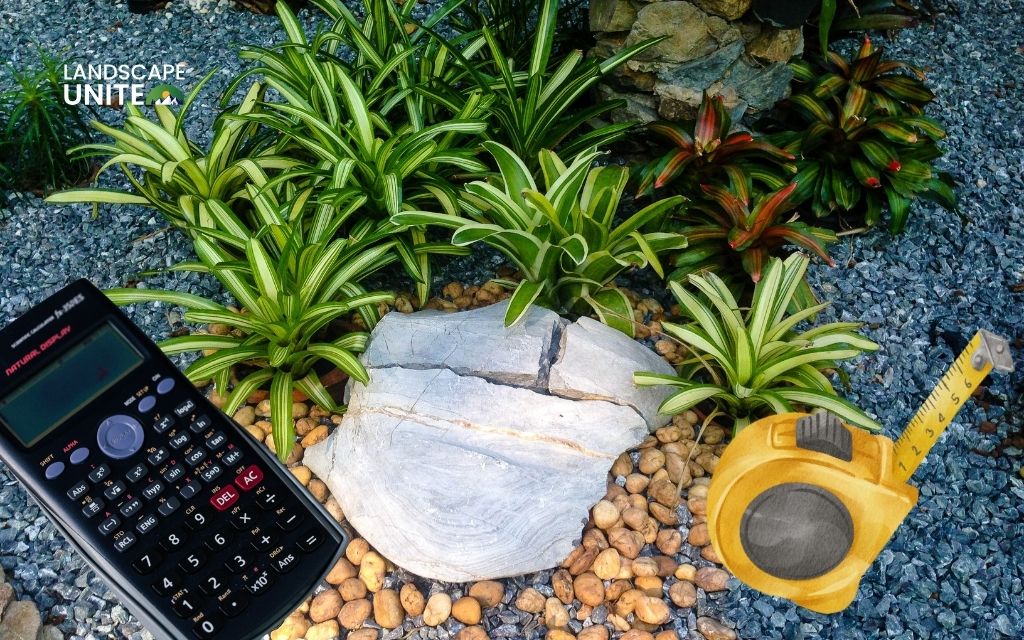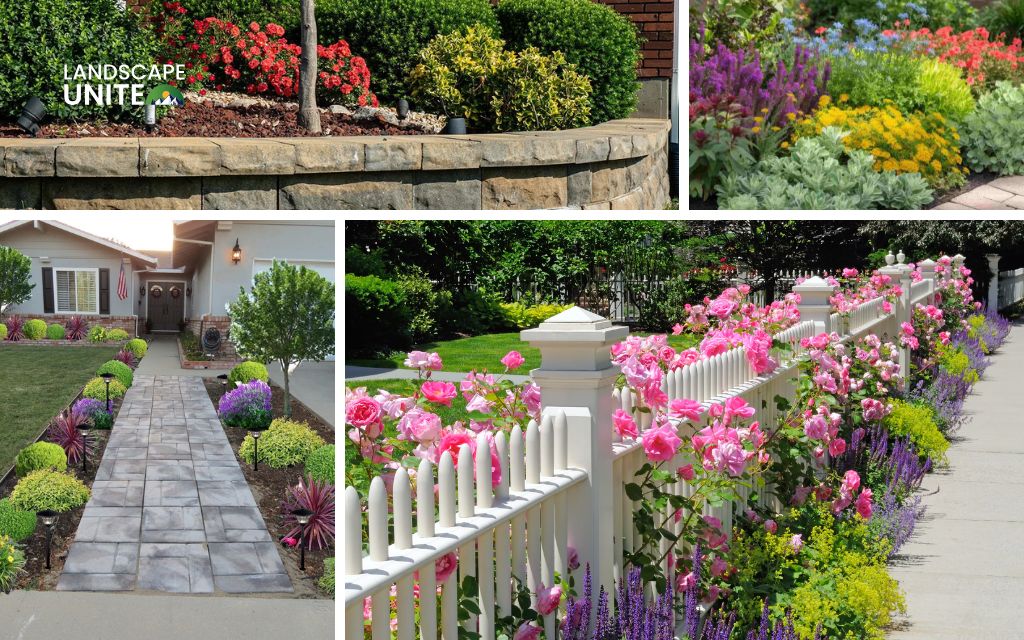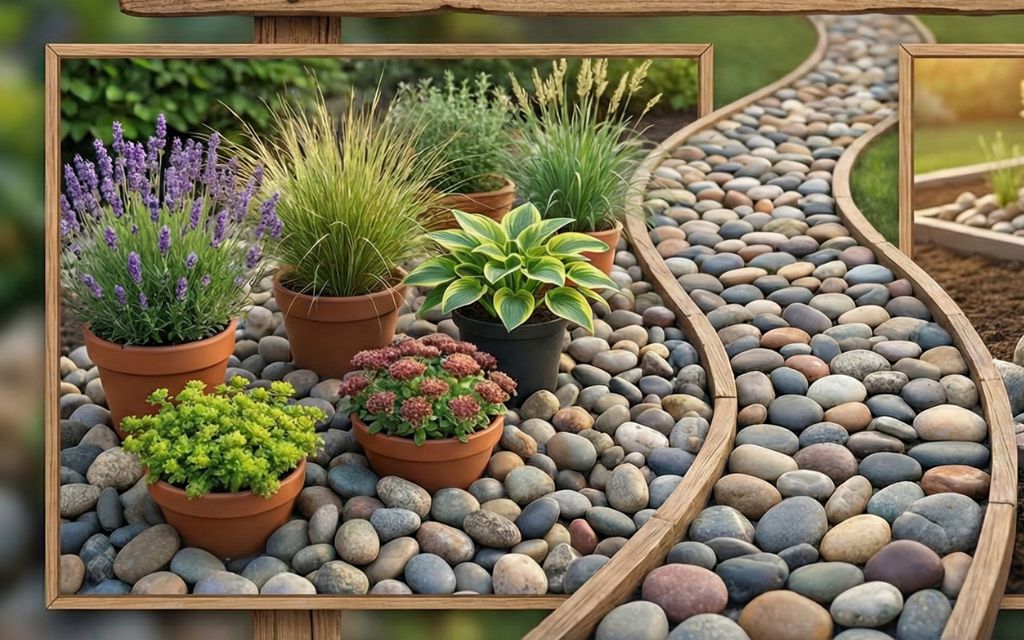After months of winter dormancy, your landscape is ready for a fresh start, and creating beautiful spring flower beds offers the ideal opportunity to welcome the growing season.
This comprehensive guide provides you with 20+ stunning spring flower beds plus plans to maintain that deliver continuous blooms from early March through late May.
Whether you’re a beginning gardener or an experienced enthusiast seeking fresh spring flower garden ideas, you’ll find practical strategies to create eye-catching displays that enhance your outdoor space.
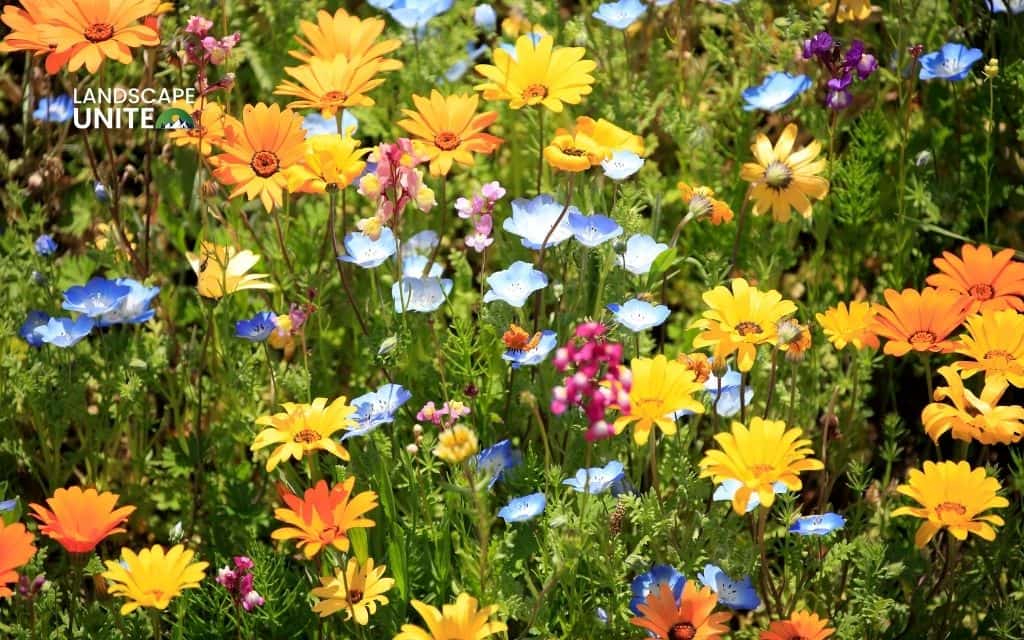
Best spring flowers for stunning flower beds (20+ ideas)
Creating spring flower beds requires selecting the right combination of blooms that provide continuous color throughout the season.
Mix these carefully chosen varieties to ensure your garden transitions seamlessly from early spring’s first hints of warmth through late spring’s abundant displays.
Early spring bloomers
Tulips
Tulips stand as the quintessential spring bulb, offering an unmatched spectrum of colors from soft pastels to bold jewel tones. These reliable performers create dramatic impact when planted in clusters of 15 to 25 bulbs, providing the foundation for many successful spring flower garden designs.
Daffodils (Narcissus)
Daffodils (Narcissus) bring cheerful yellow and white blooms that naturalize beautifully, multiplying year after year with minimal intervention. Their deer-resistant nature and early bloom time make them invaluable for spring flower beds in areas where wildlife browsing presents challenges.
Crocus
Crocus emerge as one of the season’s first brave bloomers, often pushing through late snow to deliver purple, yellow, and white flowers. These compact bulbs work wonderfully along borders, naturalized in lawns, or tucked between larger perennials where they provide early nectar for emerging pollinators.
Hyacinths
Hyacinths contribute intoxicating fragrance alongside dense spikes of pink, purple, white, or blue flowers. Plant these heavily scented blooms near walkways or seating areas where their perfume can be fully appreciated during early spring strolls.
Snowdrops (Galanthus)
Snowdrops (Galanthus) signal winter’s end with delicate, nodding white flowers that appear as early as February in warmer zones. These understated beauties excel in woodland settings or beneath deciduous trees where they bloom before the canopy leaves out.
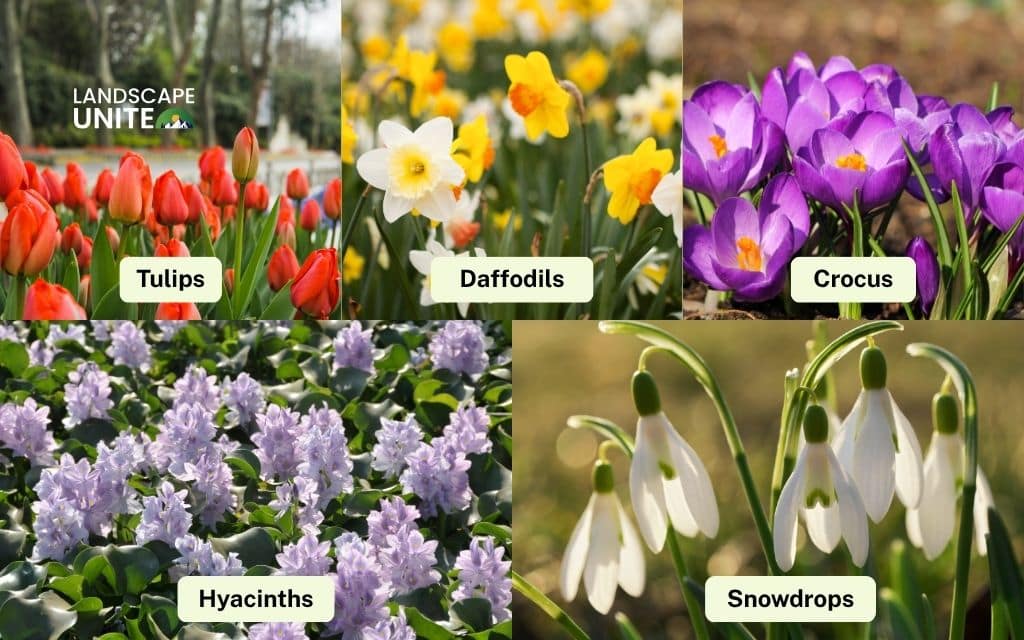
Mid-spring favorites
Pansies
Pansies deliver reliable color in cool spring weather, thriving when temperatures hover between 40-60°F. Their hardy constitution and cheerful faces make them perfect for edging spring flower beds or filling containers on patios where their multicolored blooms brighten everyday views.
Primroses (Primula)
Primroses (Primula) flourish in partial shade, offering vibrant blooms in practically every color imaginable. These low-growing perennials naturalize readily in moist, woodland-style gardens where they create carpets of cheerful flowers.
Bleeding Heart (Dicentra spectabilis)
Bleeding Heart (Dicentra spectabilis) produces distinctive heart-shaped pink or white flowers that dangle from arching stems. This shade-tolerant perennial adds architectural interest to spring flower garden designs, particularly when paired with ferns and hostas.
Forget-Me-Nots (Myosotis)
Forget-Me-Nots (Myosotis) blanket the ground with delicate blue flowers that self-seed generously. These charming bloomers work beautifully as understory plants in spring flower beds, weaving between bulbs and larger perennials.
Anemones
Anemones showcase poppy-like flowers in stunning jewel tones including deep purple, magenta, and pristine white. Their long vase life makes them excellent for cutting gardens, while their vibrant colors create focal points in mixed borders.
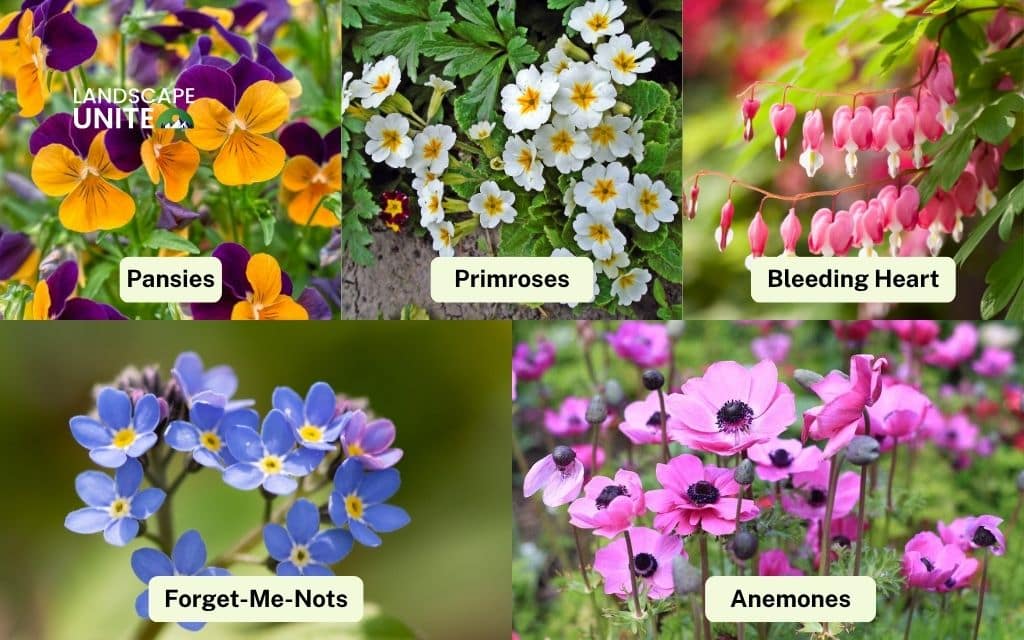
Late spring showstoppers
Peonies
Peonies reign as late spring royalty with their massive, fragrant blooms that return faithfully for decades. These long-lived perennials require patience – they can take 3 years to reach full bloom potential – but reward gardeners with unparalleled beauty and minimal maintenance requirements.
Iris
Iris bring elegant, orchid-like flowers in a remarkable color range, from soft pastels to nearly black varieties. Their sword-shaped foliage provides structural interest even after blooming ends, making them valuable year-round additions to spring flower beds.
Alliums
Alliums create stunning vertical accents with their globe-shaped purple or white flower heads that rise on sturdy stems. These ornamental onions bridge the gap between spring and summer while deterring deer and rabbits from your garden.
Columbine (Aquilegia)
Columbine (Aquilegia) produces graceful, spurred flowers that attract hummingbirds during their spring migration. These self-seeding perennials thrive in partial shade and bring airy texture to woodland spring flower garden ideas.
Lilies of the Valley
Lilies of the Valley carpet shaded areas with fragrant white bells that naturalize into charming groundcovers. While somewhat aggressive spreaders, they excel in challenging shady spots where few other flowers thrive.
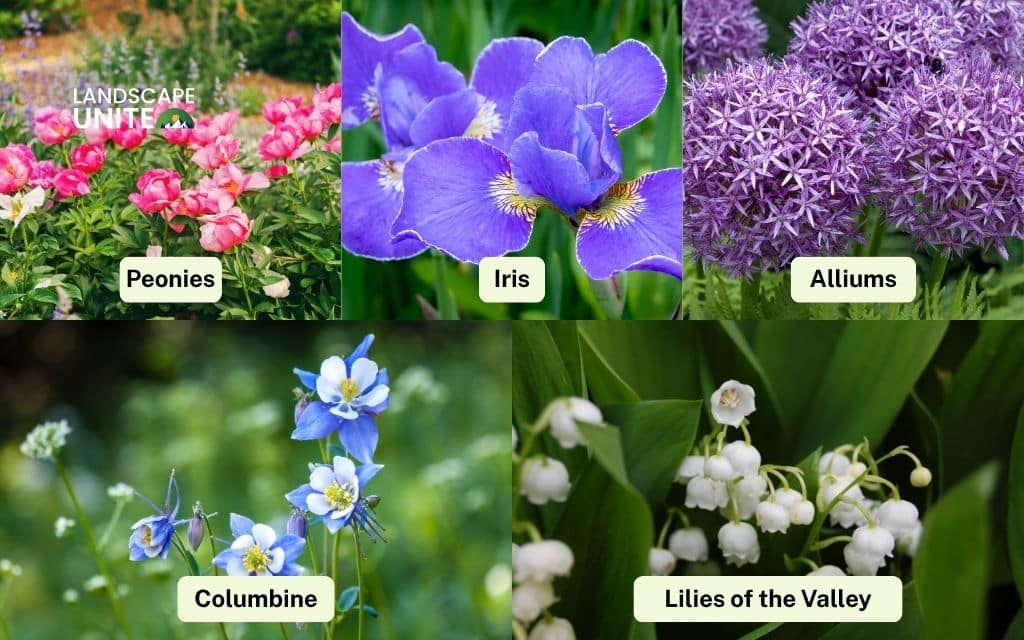
Long-blooming annuals & perennials
Geraniums
Geraniums provide dependable color from spring through fall, making them valuable workhorses in spring flower beds that transition into summer displays. Their heat tolerance and minimal care requirements suit busy gardeners perfectly.
Dianthus (Sweet William)
Dianthus (Sweet William) offers spicy-scented pink and red blooms that edge borders beautifully. These cottage garden favorites attract butterflies while their blue-green foliage provides attractive contrast throughout the growing season.
Snapdragons
Snapdragons create vertical interest with their distinctive dragon-mouth flowers available in nearly every color. Cool-season lovers, they bloom prolifically in spring before potentially taking a summer break in hot climates.
Alyssum
Alyssum forms low, spreading mounds covered in tiny white or purple flowers that emit a sweet honey fragrance. This annual filler plant softens harsh edges and fills gaps between larger specimens in spring flower bed ideas.
Marigolds
Marigolds bring golden warmth while naturally deterring many garden pests. Their hardy nature and long bloom period make them reliable choices for gardeners seeking low-maintenance, high-impact spring flower garden designs.
Coreopsis
Coreopsis delivers cheerful yellow daisy-like flowers on drought-tolerant plants that bloom from late spring through summer. These native perennials support local ecosystems while requiring minimal supplemental watering once established.
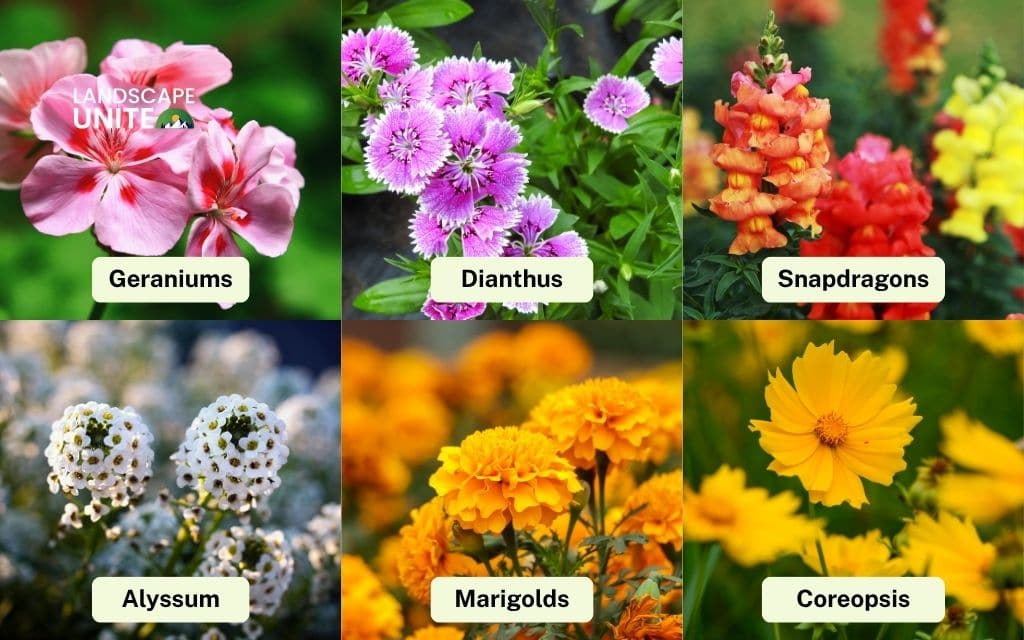
Spring flower bed design ideas
Successful spring flower beds combine thoughtful plant selection with intentional design strategies that maximize visual impact and seasonal interest.
These proven approaches help create professional-looking results regardless of your experience level.
Layering for depth and dimension
Creating depth in spring flower beds requires strategic placement based on mature plant heights.
- Position tall bloomers like tulips, irises, and alliums toward the back of borders or the center of island beds where they provide backdrops without obscuring smaller plants.
- Mid-height perennials including peonies, bleeding hearts, and geraniums occupy the middle layer, creating transition zones between tall and low-growing specimens.
- Front-edge plantings should feature groundcovers and compact varieties like pansies, primroses, and alyssum that cascade forward, softening bed edges and creating welcoming, finished appearances.
This layering technique ensures every plant remains visible while creating natural depth that draws the eye through the entire composition.
Curved edges rather than straight lines produce more natural, flowing aesthetics that complement most landscape styles. Gentle curves guide visitors along pathways while creating opportunities for strategic plant groupings that maximize color impact.
Color schemes for spring
- Soft & Romantic palettes featuring pink tulips, lavender catmint, and white daisies create tranquil, sophisticated spring flower garden designs perfect for meditation gardens or refined landscape settings.
- Bold & Vibrant schemes incorporating red tulips, orange marigolds, and purple alliums energize spaces with dynamic contrast and eye-catching intensity. These high-energy combinations suit modern landscapes or areas where you want to create strong focal points visible from a distance.
- Wildflower-inspired designs mixing native blooms in natural drifts produce organic, meadow-like aesthetics that support local ecosystems. Consider combining native coreopsis, columbine, and forget-me-nots for authentic, regionally appropriate spring flower beds.
- Monochromatic schemes using varying shades of a single color create sophisticated, cohesive displays. An all-white garden featuring snowdrops, white tulips, white pansies, and white bleeding hearts appears luminous in evening light while providing calming visual unity.
Container & raised bed options
Container plantings expand possibilities for gardeners with limited space or challenging soil conditions.
- Large containers accommodate complete spring flower bed ideas in miniature, combining bulbs planted at varying depths with annuals at soil level for dynamic, season-long displays.
- Raised beds offer superior drainage for bulbs while bringing flowers closer to eye level where their beauty can be fully appreciated.
These structures also warm faster in spring, encouraging earlier blooms and extending your growing season.
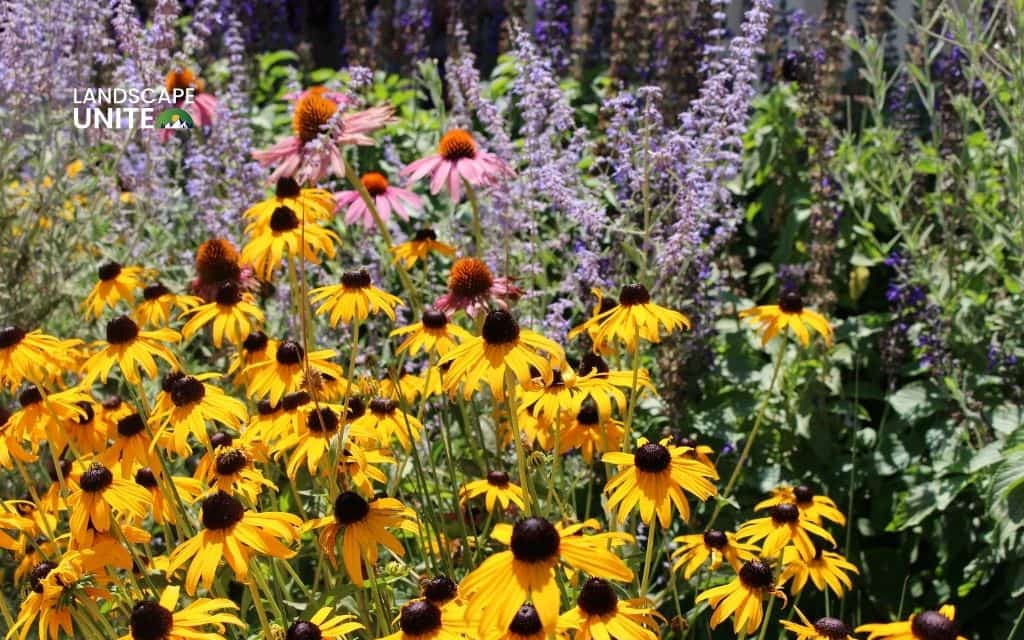
Why spring flower beds matter
Beyond their obvious aesthetic appeal, well-planned spring flower beds provide multiple benefits that enhance your landscape’s ecological function and long-term sustainability.
A fresh start for the growing season
Spring flower beds rejuvenate your landscape after winter’s dormancy, reestablishing your outdoor space as a vibrant, welcoming environment.
These early plantings set your garden’s color theme and style direction for the entire year, creating cohesive visual flow as later-blooming perennials and summer annuals join the display.
Early spring blooms also boost mental wellbeing during the transition from winter to warmer seasons. Research demonstrates that interaction with flowering plants reduces stress and improves mood – benefits particularly valuable as we emerge from winter’s isolation.
Supporting pollinators
Early-blooming spring flowers provide critical nectar and pollen sources for bees, butterflies, and hummingbirds emerging from winter dormancy or completing spring migrations.
Many native bees emerge in early spring when food sources remain scarce, making your spring flower beds potentially vital to their survival.
Including native plant species in your spring flower garden designs helps maintain balanced local ecosystems by supporting specialist pollinators that depend on specific plant relationships. Native columbine, coreopsis, and bleeding hearts evolved alongside local pollinator populations, providing perfectly timed nutrition.
Sustainability & low maintenance
Choosing perennials and native species for spring flower beds reduces long-term maintenance while delivering reliable annual displays. Unlike annuals requiring yearly replanting, established perennials return dependably, often increasing in size and bloom quantity over time.
Incorporating compost and organic mulch enriches soil naturally, reducing or eliminating synthetic fertilizer needs. These organic amendments improve soil structure, moisture retention, and beneficial microbial activity – creating healthier growing conditions that support robust plant growth.
Many spring bulbs and perennials demonstrate excellent drought tolerance once established, reducing supplemental irrigation requirements. This water conservation becomes increasingly important as climate patterns shift and water resources face greater pressure.
How to plant and maintain spring flower beds
Successful spring flower beds begin with proper preparation and continue with consistent seasonal maintenance that keeps displays healthy and attractive.
- Prepare the soil by incorporating 2 – 3 inches of compost or well-rotted organic matter before planting. This amendment improves drainage in heavy clay soils while enhancing moisture retention in sandy conditions.
- Plant bulbs early during fall months, typically September through November depending on your hardiness zone. Spring-blooming bulbs require 12 – 16 weeks of cold temperatures to develop properly.
- Water consistently, especially during dry early spring periods. Newly planted areas require more frequent watering than established beds – check soil moisture regularly and water when the top inch feels dry.
- Mulch and edge beds to maintain neat appearances while retaining soil moisture and suppressing weed growth. Apply 2 – 3 inches of organic mulch around plants, keeping material pulled back slightly from stems to prevent rot. Define bed edges annually to maintain crisp borders.
- Deadhead and divide plants to extend bloom periods and maintain plant health. Remove spent flowers before they set seed, directing plant energy toward continued blooming rather than seed production. Divide overcrowded perennials every 3 – 5 years, refreshing soil and sharing divisions with gardening friends.

Conclusion
Spring represents your opportunity to reimagine outdoor spaces with vibrant color, engaging texture, and delightful fragrance that welcomes the growing season.
From classic tulips creating bold statements to fragrant peonies offering romantic charm, there’s a perfect flower for every garden style, space constraint, and skill level.
The spring flower bed ideas presented here provide pathways to creating stunning displays that support local ecosystems, embrace sustainable gardening practices, and deliver months of visual pleasure. Whether you’re designing intimate container gardens or expansive border plantings, these proven strategies ensure success.
Looking for more expert guidance on creating beautiful flower beds? Dive into our garden knowledge library for proven tips and techniques.
Frequently asked questions (FAQs)
When should I start planting my spring flower bed?
Plant spring-blooming bulbs during fall months, typically September through November depending on your USDA hardiness zone. Bulbs require extended cold periods to develop properly. Annual flowers and container plantings should be added after your area’s last expected frost date, generally March through May across most US regions.
What flowers bloom all spring long?
Pansies, violas, and snapdragons provide continuous blooms from early through late spring when planted in cool weather. For extended displays, combine early bulbs like crocuses with mid-season tulips and late-blooming alliums, creating succession planting that ensures constant color.
How do I keep my spring flower beds blooming longer?
Combine early, mid, and late-blooming varieties to create seamless seasonal transitions. Deadhead spent flowers regularly to redirect plant energy toward continued blooming rather than seed production. Apply balanced, slow-release fertilizer in early spring to support robust growth. Adequate watering during dry spells prevents stress that can shorten bloom periods.
What are good low-maintenance spring flowers?
Daffodils, tulips, and perennial geraniums require minimal care once properly established. These reliable performers naturalize readily, returning year after year with little intervention beyond occasional division. Native species like coreopsis and columbine adapt well to local conditions, requiring less supplemental watering and fertilizing than exotic varieties.
Can I plant bulbs and annuals together?
Yes! Layer spring bulbs 6 – 8 inches deep in fall, then add cool-season annuals like pansies or primroses at soil level the following spring. This technique creates full, colorful displays that maximize planting space. The annuals provide immediate color while bulbs emerge through them, and annual roots occupy different soil levels than bulb roots, preventing competition.
